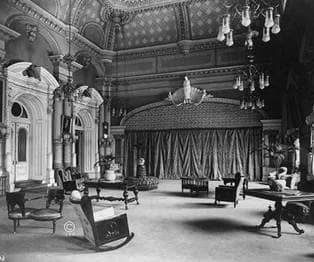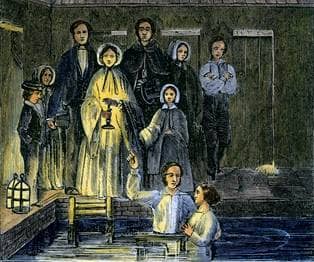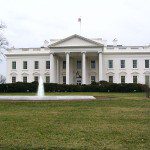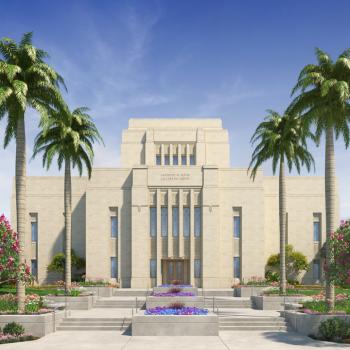- Trending:
- Forgiveness
- |
- Resurrection
- |
- Joy
- |
- Afterlife
The LDS Church - Rituals & Worship
Sacred Time
Members of the Church of Jesus Christ of Latter-day Saints, from the earliest days of the group, have maintained a relatively simple approach to sacred time and the liturgical calendar. Mormons celebrate Christmas and Easter, but they do not mark any of the other days of the liturgical calendars of Catholic and many Protestant Christian groups.
Like most other Christians, however, Mormons set aside Sunday as the "Sabbath." On this holy day, Mormons attend a series of meetings that typically last two hours. During these meetings, they participate in the sacrament of the Lord's Supper and attend classes that focus on scripture study and gospel principles. The Sacrament meeting forms the core of the worship services and is attended by all members of the congregation. During this meeting, two or three members of the congregation share 10-15 minute talks prepared in advance on a topic often chosen by the bishop of the congregation. Other classes are divided by age and gender. Members of the Church avoid shopping or attending recreational events on Sunday, and instead focus on attending meetings and spending time with family members. In addition, they set aside Monday evenings as a period of family togetherness, called "Family Home Evening."
One Sunday a month, usually the first Sunday, is set aside for fasting for a period of 24 hours. The Sacrament meeting on Fast Sunday consists of the sharing of testimonies by any members of the congregation who choose to participate. The members are also encouraged to donate the money they would have spend on food and drink during the 24 hour period toward a "Fast Offering." These funds are allocated toward members of a congregation who have temporal needs and require help under the direction and discretion of the Bishop.
The Sabbath is set apart as a sacred period designed to renew and refresh religious commitments and teachings before they re-engage with their regular lives of work during the week. Twice a year, in April and October, members of the LDS Church (Church of Jesus Christ of Latter-day Saints) gather for General Conference. During this two-day series of meetings, members of the Church are instructed on theology and doctrine via sermons delivered by members of the Church's presiding authorities-- The President and his counselors, members of the Quorum of the Twelve Apostles, and more. This broadcast happens the first weekend of April and October and is broadcasted all over the world via cable, internet, and streaming services. The public is invited to watch.
Within LDS temples, the most liturgically sophisticated enactment of sacred time occurs. Rituals take place for the living to make sacred covenants with God in the temple that help the individual link their promises they make on Earth to the Savior Jesus Christ and the Gospel. The entire focus of the temple is similar to that of the Temple of Solomon and the Tabernacle of the Israelites. The temple is "set apart" from the world, it is purposely a different place thus the reason why members must be in good standing to attend the temple ceremonies. The temple focuses on where we came from, why we are here, and where we are going dependent on the obedience, covenants, and faithfulness to Jesus Christ. The temple is a sacred place for members of the Church and due to the sacredness of the rituals involved, members are discouraged from casually talking about what happens inside the temple. The Church has become more transparent about the temples, garments, and more related to its rituals in the past 5 years.
In addition to the lived experience of weekly sacred time, General Conference, family home evening, and the temple, Mormons also engage the idea of sacred time on a theological level. Mormons believe that they are living in the final period of human history, which will end with the return of Jesus Christ to the earth, and that it is their duty to prepare the earth for Christ's second coming (the parousia).
After the Second Coming, Mormons believe that Christ will reign on the earth and Satan will be bound for 1,000 years. During this period, people will live and work on the earth, but will be able to do so without the temptations of Satan and without the interference of wicked persons. Mormons expect Christ to stand at the head of a world government during this period.
LDS scripture also deals with God's conception of time, although conflicting scriptural passages complicate the subject. The Book of Abraham, a text that Smith claims to have translated from ancient papyrus scrolls that he found among some mummies he purchased in 1835, teaches that God does not exist beyond time, but that he experiences time differently than human beings, with one of God's days equaling 1,000 earth years. While technically part of LDS theology, the specific ratio of God's day to human years is considered by modern Mormons to be somewhat esoteric, and many Mormons probably are not aware of it. The majority of Mormons are more familiar with yet another formulation, drawn from the more widely-read The Book of Mormon, which holds that "all is as one day with God, and time is only measured unto men." Time is just a mortal concept used to explain patterns of history, but to God all things are present before Him.
- What holidays do Mormons share with Christians?
- Describe the Mormon understanding of the Sabbath.
- How do the temples transform understandings of time and space?
- What is the parousia? What will happen following it?
Sacred Space
Most religious traditions have some concept of sacred space—physical spaces set apart from the ordinary, "profane" world. Mormonism approaches sacred space in a number of different ways of varying intensity. In a technical sense, any physical space that is ceremonially dedicated by the LDS (Church of Jesus Christ of Latter-day Saints) priesthood may be considered sacred space. At the most basic level, Mormons believe that their homes should be holy places where the Holy Ghost can be present. Many Mormons dedicate their homes in a brief and informal ritual in order to set the home apart from its profane surroundings. Homes are considered sacred because they house the family and, therefore, should provide the proper atmosphere for spiritual development.
Similarly, LDS chapels, which are buildings that host Sunday worship services and various weekday activities, are also dedicated through a slightly more formal ritual in which a prayer is spoken by a local Church leader. Chapels are the sites of the sacred Mormon ritual in which emblems representing Christ's flesh and blood are blessed and distributed to the congregation. In the case of homes and chapels, the dedications as sacred space do not carry limits on who may or may not enter.
LDS temples, however, represent the fullest expression of the idea of sacred space within Mormonism. The dedications of these buildings are more ritually complex and, once dedicated, may only be entered by members of the LDS Church who are in good standing and who hold a temple recommend. In order to obtain a temple recommend, Mormons must attest to two separate ecclesiastical leaders their belief in core Mormon doctrinal teachings and their adherence to a variety of Church rules, including abstinence from tea, coffee, tobacco, and alcohol, and laws of sexual purity. Within the temples, worthy Mormons perform a variety of rituals both for themselves as well as on behalf of deceased ancestors. Rituals of initiation and instruction as well as marriage for time and eternity, baptisms and ordinations to the priesthood all occur within the temples where living Mormons stand in as proxies for the dead.
In addition to specific buildings that take on the identity of sacred space through dedication, Mormons have also attached sacred significance to certain geographical spaces. In the early years of the movement, Joseph Smith claimed to have been commanded by God to dedicate a piece of land near Independence, Missouri, as the site of the sacred city to which Christ would return at his second coming. The Mormons dedicated the land and began to gather there, but were eventually forced to flee because of violent attacks made by some of the original settlers of the area.
This pattern of dedicating continues today, although in a slightly different form. This type of dedication of geographical sacred space typically occurs in the form of the dedication of a nation for the preaching of the gospel by LDS missionaries. Once land is dedicated, Mormons believe that missionaries will enjoy increased success in gaining converts to the faith in the region.
- Where does sacred space exist within the Mormon tradition?
- What is the role of ritual within Mormon sacred space?
- Who may enter a Mormon temple?
- How does land become sacred?
Rites and Ceremonies
Mormonism is generally considered to be a liturgically simple faith because it lacks complex and ornate public rituals. This is a reasonable assessment, but the private temple rituals are considerably more sophisticated. Although Mormons do not baptize children until they are 8 years old, Mormon infants are publicly named and blessed in a ritual that is performed in front of the child's home congregation. This ritual, as with all public rituals, is performed by a lay male member of the Church who holds the Church's priesthood. In most cases, this means that the father or husband of the family performs the ritual.
The priesthood in the LDS Church (Church of Jesus Christ of Latter-day Saints) is divided into two parts: the lesser, or Aaronic priesthood, and the higher, or Melchizedek priesthood. Only males are eligible for ordination, which occurs at the age of twelve for the Aaronic and eighteen for the Melchizedek.
The most frequently performed public Mormon ritual is the faith's version of the common Protestant and Catholic rituals of "communion." The Mormon ritual of "sacrament" originated with a revelation recorded by Joseph Smith in April 1830, which enjoined the Mormons to "meet together often to partake of the bread and wine in remembrance of the Lord Jesus." This revelation translated into the practice of weekly sacrament meetings. Individuals who have been ordained to the priesthood, usually younger men and boys with the Aaronic Priesthood, consecrate bread and water through formal prayers with a set wording. After the emblems are blessed, they are distributed to the congregation by other Aaronic priesthood holders. This ritual is designed to renew the covenants that Mormons make at baptism to obey God's commandments, to remember in daily life the sacrifice of Christ, and to ensure that God's spirit may constantly accompany the participant.
Mormons practice baptisms by immersion, which are usually performed in fonts located in LDS chapels (although in some cases baptisms are performed in natural bodies of water). This ritual is typically performed shortly after a child of Mormon parents turns 8 years old. Like the sacrament, the rite of baptism follows a set prayer and can be performed by one holding the Aaronic priesthood, although often the child's father or an adult friend with the Melchizedek priesthood performs the ordinance. Adults who join the Church are also baptized following the same ritual.
Baptism is followed by an accompanying rite that involves the conferral of the Gift of the Holy Ghost upon the newly baptized member. This ritual must be performed by one holding the Melchizedek (or higher) priesthood who places his hands on the recipient's head and confers the gift. Other rituals include the conferral of priesthood authority and the blessing of the sick. In both cases, the rituals are performed by an individual who holds the Melchizedek priesthood placing his hands on the head of the recipient and speaking prayers without formal wording.
The private rituals of Mormonism take place within the Church's temples and may only be performed or witnessed by members of the Church who are in good standing. Although Mormons who have participated in these rituals take solemn vows not to disclose the specifics of the ceremonies to anyone, the LDS Church has published general descriptions of the rites. The main temple ritual is called the "endowment" and consists of a recitation of the main events of sacred history, including the creation of the earth and the events that took place in the Garden of Eden, as well as a process of covenant making in which the initiate agrees to live according the teachings of the LDS Church. Worthy Mormons also participate in ceremonies of "sealing" in which spouses are married for eternity and in which children are bound to their parents in an eternal family unit. In both the endowment and sealing rituals, Mormons dress in ceremonial clothing, a practice that adds to the liturgical richness and complexity of the temple rites.
LDS temples are also the sites for rituals performed on behalf of the dead. LDS doctrine maintains that individuals who die without knowledge of the true gospel must be provided with an opportunity to accept those teachings in the afterlife. It is the responsibility of faithful Mormons to search out the genealogical records of their ancestors and to perform by proxy all of the sacred ordinances and rituals of Mormonism. Mormons are thus baptized, endowed, and sealed during temple rituals in which they stand in for those who are deceased. The rituals performed in temples, in contrast to the public rituals, are presided over and, in the case of sealings, performed by individuals with special responsibility for temple work.
Mormons also perform simple rituals associated with death. Mormon funerals tend to be occasions for large family gatherings, with an emphasis on the life of the deceased and the importance of eternal family relationships. Mormons who have been through the endowment rituals are typically buried in their ritual temple clothing. Often, the grave is dedicated by a Melchizedek priesthood holder through an informal prayer asking God to protect the grave and its occupant until the time of resurrection.
- Why is Mormonism considered to be a liturgically simple faith? What rituals does it celebrate?
- Describe the ritual of communion as practiced by Mormons.
- How is the ritual of baptism performed?
- What rituals are associated with the dead? Why are they important?
Worship and Devotion in Daily Life
Mormons focus their worship in Sunday meetings but then attempt to reinforce their faith daily through a series of prescribed practices. Sunday worship services consist of a three-hour block of meetings. Sacrament meeting, a gathering that lasts a little more than an hour and that features sermons from members of the congregation and the performance of the sacramental ritual of the Lord's Supper, is the focal point of Sunday worship services.
In addition to this main meeting, children attend classes called Primary, and teenagers and adults attend classes on scripture and LDS (Church of Jesus Christ of Latter-day Saints) history. Adult men attend priesthood meetings that are divided according to age and rank in the priesthood while adult women attend a meeting of the women's auxiliary, which is called the Relief Society. Mormons who hold lay leadership positions attend additional administrative meetings on Sundays either before or after the main block of devotional meetings.
During the week, high school students attend courses of religious instruction. These "seminary" classes are held before school in areas where LDS population is sparse, and during school hours in Utah, Idaho, and other areas where Mormons are the dominant religious group. Mormon teenagers also meet for a variety of activities involving recreation and service projects. Similarly, adult Mormon women occasionally hold "enrichment" meetings on weekday evenings. Within Mormon homes, daily prayer and scripture study is considered ideal, and many families make concerted efforts to gather children and parents for group prayers morning and evening, and scripture study sessions either early in the morning or in the evening. Monday nights are reserved for "family home evening"—a time when the family gathers for a gospel lesson, games, or other recreational activities.
Men and women are also assigned in pairs to be "home teachers," in the case of the men, and "visiting teachers," in the case of the women. Male home teachers generally meet with all the members of a family, while female visiting teachers usually meet only with the adult females in the family. These paired companionships are assigned to visit a list of families in the congregation once each month. The Church's official magazine, the Ensign, contains the official message for the month from Church headquarters that home and visiting teachers are expected to deliver. In addition to teaching the message from the Ensign, home and visiting teachers also ask about the general welfare of the families they visit and report any problems or needs to the bishop of the ward (congregation). Mormons are thus expected to visit a number of families each month in this capacity, and also to make time for home and visiting teachers to visit them in their homes once a month.
LDS temples also play a major role in the devotional life of Mormons. Mormons are encouraged to qualify for a temple recommend, which is a document certifying that the holder lives in accordance with Mormon standards of sexual purity, doctrinal orthodoxy, the Mormon dietary laws, and other rules. Nearly 130 temples are in operation worldwide. Qualified Mormons who live close to one of these are expected to attend temple services with some regularity. Within the temples, Mormons participate in rituals called endowments and sealings that involve covenant making and the creation of eternal families. Once a Mormon has personally received these rites, he or she then returns to perform them on behalf of deceased ancestors or other deceased persons. After receiving the endowment, a Mormon is expected to wear special underclothing called "garments." These white undergarments are available in a variety of fabrics and are to be worn night and day throughout the endowed person's life. For Mormons, these garments function as a reminder of the sacred covenants made in the temples, and serve as a protection against evil and temptation.
- Describe Sunday worship for a Mormon.
- Describe the role between education and mission.
- How are the lessons of Home Teachers kept consistent?
- What is a temple recommend? What privilege does it grant to Mormons?
Symbolism
Mormons display a variety of religious symbols, some of which are similar to other Christian groups, and others that are unique to Mormonism. The Mormon ritual of the "sacrament" involves the consumption of bread and water that stand as symbols for the flesh and blood of Jesus Christ. The ritual of baptism, which for Mormons involves total immersion, symbolizes the death, burial, and resurrection of Christ.
In these instances, Mormon use symbols commonly employed by other Christians. One conspicuous difference is the absence of the cross. Some Mormons explain their reluctance to use the cross as an aversion to the emphasis on Christ's death when Mormons prefer to emphasize the Resurrection. Mormon chapels are usually adorned with a simple spire to mark them as church structures.
Mormon temples typically are topped by a large golden statue of an angel blowing a trumpet. This angel, named Moroni, is believed to be the being who delivered to Joseph Smith the golden plates that were translated and published as The Book of Mormon. Mormons also believe that Moroni is the angel referred to in the Revelation of St. John, which speaks of an "angel . . . in the midst of heaven, having the everlasting gospel" and is therefore represented on the temples as holding a trumpet with which to declare the true religion. In a reflection of Mormonism's apocalyptic roots, the angel statues on the temples face east in anticipation of Christ's second coming.
Some LDS (Church of Jesus Christ of Latter-day Saints) temples bear additional architectural symbols. The temple in Salt Lake City, Utah, which has special significance as the site of meetings of the Church's governing quorums, has three towers on the west side, representing the Church's Presiding Bishopric, and three slightly taller towers on the east, representing the Church's governing First Presidency. Carved into the exterior granite walls are representations of various celestial bodies, including stars, moons, and suns, which stand as symbols of the Mormon belief in a three-tiered afterlife in which the three "degrees of glory" kingdoms are said to possess the brightness of stars, the moon, and the sun, respectively. In the basement of each temple is a font for baptisms that is built upon the backs of twelve stone or bronze oxen, representing the twelve tribes of ancient Israel. In the sealing, or marriage, rooms of the temples, large mirrors are mounted on opposite walls, creating the symbol of an eternal union between husband and wife.
Within the temples, Mormons engage in rituals that are rich in symbolic meaning, although they are under sacred obligations not to disclose the detailed meaning of these symbols outside of the temple. During the ritual of "initiatory," Mormons are symbolically washed and pronounced clean from sin. The "endowment" involves a symbolic depiction of sacred history and a journey thorough mortal life and into the realm of life after death. Much of this symbolism involves sacred robes and ritual handclasps that are used as part of this symbolic journey. Mormons leave the temple with a symbolic reminder, in the form of a white undergarment, of the covenants and teachings they witnessed within. Mormons are reticent to speak in detail about these "garments," but they serve as a tactile reminder of the temple experience and as a boundary between the believer and the profane world.
Other, less ritualistic, symbols also appear within Mormon life and culture. For example, the beehive, a symbol of industry and energy in a righteous cause is used as a symbol on some temple doorknobs and as the seal of the Church-owned Brigham Young University in Provo, Utah.
- How does the symbol of the cross differ from Christianity's understanding?
- How is Moroni symbolized? What direction does he face, and why is this important?
- How are symbols utilized in Mormon architecture?
- Describe the ritual of initiatory. What are its inward and outward symbols?







